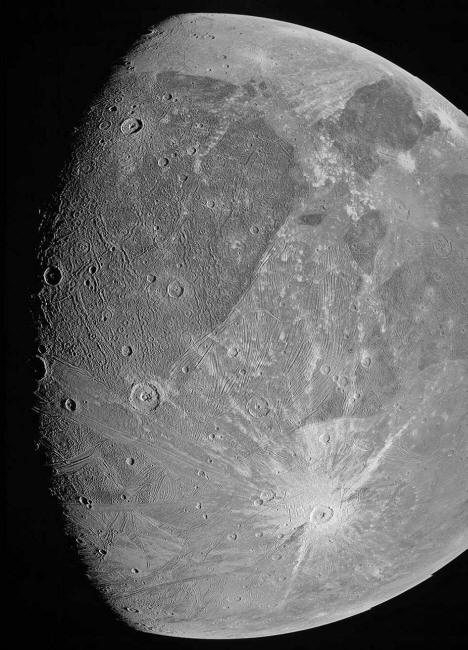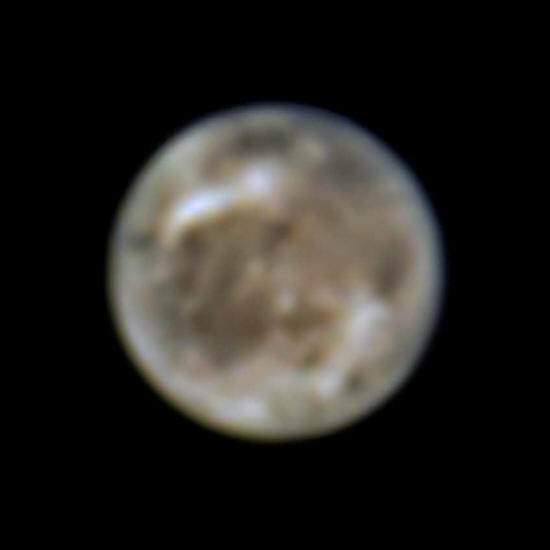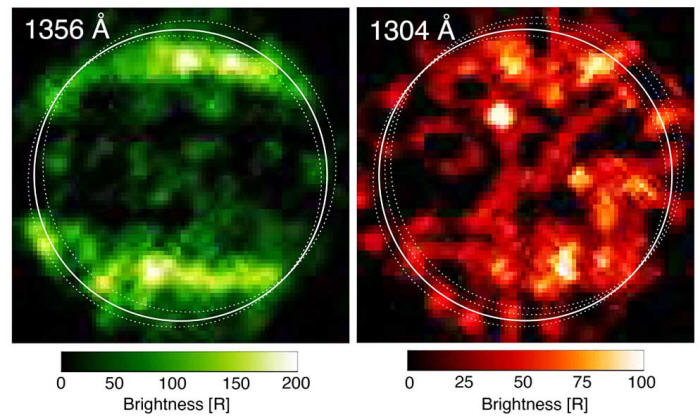|
by Lynn Jenner December 21, 2021 from NASA Website
This image of Ganymede was obtained by the JunoCam imager
during Juno's June 7, 2021, flyby of the icy moon.
Scientists used new and archival datasets from NASA's Hubble Space Telescope to make the discovery, published in the journal Nature Astronomy (A sublimated Water Atmosphere on Ganymede detected from Hubble Space Telescope observations).
as seen by the NASA's Hubble Space Telescope in 1996. Ganymede is located half a billion miles (over 600 million km) away, and Hubble can follow changes on the moon and reveal other characteristics at ultraviolet and near-infrared wavelengths. Astronomers have now used new and archival datasets from Hubble to reveal evidence of water vapor in the atmosphere of Jupiter's moon Ganymede for the first time, which is present due to the thermal escape of water vapor from the moon's icy surface. Credits: NASA, ESA, John Spencer (SwRI Boulder)
However, temperatures there are so cold that water on the surface is frozen solid.
Ganymede's ocean would reside
roughly 100 miles below the crust; therefore, the water vapor would
not represent the evaporation of this ocean.
At the same time,
scientists concluded this discrepancy was likely related to higher
concentrations of atomic oxygen (O).
The team's analysis combined the data from two instruments:
...from 1998 to 2010.
Ganymede's surface temperature varies strongly throughout the day, and around noon near the equator it may become sufficiently warm that the ice surface releases (or sublimates) some small amounts of water molecules.
In fact, the perceived differences in the UV images are directly correlated with where water would be expected in the moon's atmosphere.
Hubble's Space Telescope Imaging Spectrograph took these first ultraviolet images of Ganymede, which revealed a particular pattern in the observed emissions from the moon's atmosphere. The moon displays auroral bands that are somewhat similar to aurora ovals observed on Earth and other planets with magnetic fields. This was an illustrative evidence for the fact that Ganymede has a permanent magnetic field. The similarities in the ultraviolet observations were explained by the presence of molecular oxygen. The differences were explained at the time by the presence of atomic oxygen, which produces a signal that affects
one UV
color more than the other.
This finding adds anticipation to ESA (European Space Agency)'s upcoming mission, JUICE, which stands for JUpiter ICy moons Explorer.
JUICE is the first large-class mission in ESA's Cosmic Vision 2015-2025 program.
Planned for launch in
2022 and arrival at Jupiter in 2029, it will spend at least three
years making detailed observations of Jupiter and three of its
largest moons, with particular emphasis on Ganymede as a planetary
body and potential habitat.
Right now, NASA's Juno mission is taking a close look at Ganymede and recently released new imagery of the icy moon.
Juno has been studying Jupiter and its environment, also known as the Jovian system, since 2016.
Astronomers have used new and archival datasets from NASA's Hubble Space Telescope to uncover evidence of water vapor in the atmosphere of Jupiter's moon Ganymede. The vapor is present due to the thermal excitation of water molecules from the moon's icy surface. Previous research has offered circumstantial evidence for the moon containing more water than all of Earth's oceans. However, temperatures there are so cold that water on the surface freezes and the ocean
lies roughly 100 miles below the crust.
In addition, new insights will hopefully be found on the habitability of Jupiter-like exoplanetary systems.
|




